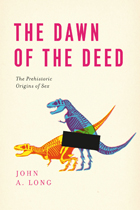

Males are promiscuous and ferociously competitive. Females--both human and of other species--are naturally monogamous. That at least is what the study of sexual behavior after Darwin assumed, perhaps because it was written by men. Only in recent years has this version of events been challenged. Females, it has become clear, are remarkably promiscuous and have evolved an astonishing array of strategies, employed both before and after copulation, to determine exactly who will father their offspring.
Tim Birkhead reveals a wonderful world in which males and females vie with each other as they strive to maximize their reproductive success. Both sexes have evolved staggeringly sophisticated ways to get what they want--often at the expense of the other. He introduces us to fish whose first encounter locks them together for life in a perpetual sexual embrace; hermaphrodites who "joust" with their reproductive organs, each trying to inseminate the other without being inseminated; and tiny flies whose seminal fluid is so toxic that it not only destroys the sperm of rival males but eventually kills the female. He explores the long and tortuous road leading to our current state of knowledge, from Aristotle's observations on chickens, to the first successful artificial insemination in the seventeenth century, to today's ingenious molecular markers for assigning paternity. And he shows how much human behavior--from the wife-sharing habits of Inuit hunters to Charlie Chaplin's paternity case--is influenced by sperm competition.
Lucidly written and lavishly illustrated, with a wealth of fascinating detail and vivid examples, Promiscuity is the ultimate guide to the battle of the sexes.

"A must read for anyone interested in evolution, mating/social systems, and population ecology."—John L. Koprowski, IJournal of Insect Behavior

As Darwin first pointed out, two distinct evolutionary processes have contributed to the diversity of form and function in plants and animals: natural selection and sexual selection. In this book William Eberhard presents a new theory that explains male genitalic evolution as a result of sexual selection. From flatworms to fish, from moths to rodents, animal genitalia display an extraordinary variety of baroque morphologies. Not only are the forms varied, they have diverged rapidly in the course of evolution.
Why such strange forms and such rapid divergence? These questions have puzzled evolutionary biologists and animal taxonomists for over a century, and several hypotheses have been proposed. Eberhard shows that none of the explanations is adequate and proposes a new hypothesis. He views genitalia as courtship devices that function in the competition for mates by influencing the females' choices of fathers for their offspring. To the extent that male genitalic structures affect female choices, male genitalia are subject to the same type of runaway selection as that on structures, such as the peacock's tail, used in precopulatory courtship.
Eberhard's hypothesis can explain the fact that in a vast range of animals, from nematodes to mammals, male genitalia tend to be more complex than female genitalia, are often more elaborate than would be required for simply introducing sperm into the female's body, and have diverged rapidly and are thus highly species-specific in form. Although the emphasis is on theoretical explanations, many examples are presented of the vast diversity of animal genitalia: squids with arms whose tips break off and swim around inside the female after introducing an explosive, grenade-like sperm packet into her; flatworms that have rows of penes despite the presence of only a single female aperture; damselflies that give their mates contraceptive douches prior to inseminating them; and female seahorses with penes.
READERS
Browse our collection.
PUBLISHERS
See BiblioVault's publisher services.
STUDENT SERVICES
Files for college accessibility offices.
UChicago Accessibility Resources
home | accessibility | search | about | contact us
BiblioVault ® 2001 - 2025
The University of Chicago Press









